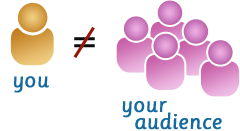Industry Speak
Posted by Emily Cotler
 A frequent problem in any industry is the tendency to speak to your audience in terms and timing that make sense to you. But you are on the inside. Your audience is not. But the same thought process should be considered when writing web copy.
A frequent problem in any industry is the tendency to speak to your audience in terms and timing that make sense to you. But you are on the inside. Your audience is not. But the same thought process should be considered when writing web copy.
I have a client who uses the term “POV” in her blogging and other webcopy. And while her writerly site visitors might know that POV refers to character Point Of View (aka, who is speaking, whose head are we in), most readers do not. It can be jarring for them. Moreover, when they are next reading your work, they might slip out of reading mode to notice your POV change. Suddenly, reading is no longer an immersive experience, and the brand has a seam.
It’s a matter of putting yourself in your visitors’ shoes. Speak in terminology that is meaningful to them. When you don’t, you risk mismessaging. And while sometimes that means that your message simply might not translate, it also can mean that you actually offend the reader since suddenly they have no idea what you are talking about (and no one likes to feel ignorant). And when you are writing fan-based web copy your goal is to connect, not to jar. Speaking a different language will not help.
Audience-aimed copy can also work towards luring your audience into a tighter bond with you. An example: I regularly advise author clients not to announce new books in terms of contracts: “Good news! I just signed a contract for two more books!” This is industry speak. Now look how much more audience-oriented this is:
“Good news — more books to come. You can now count on two more books from me in 2016! Stay tuned for titles and more definitive dates.”
This is meaningful to the audience. You are putting it in their terms, that they get to read more books (not that you will remain gainfully employed). Moreover, you allow for a little magic to be retained. Instead of putting your future booklist in terms of negotiations and contracts, it can feel unencumbered and organic, as if the stories flow from your hand to theirs without the tedium and tension of publishers and distribution and all that in between. You are in the business of expecting your consumers to suspend reality. Don’t shoot yourself in the foot by demystifying your product. There is no need to advertise how much of a product your product is.
Think like your audience. How do you want them to read your news?


